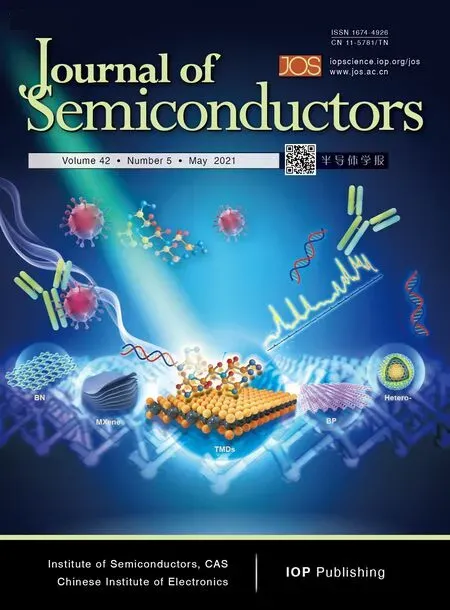Intramolecular spatial charge transfer enhances TADF efficiency
Baoyi Ren,Chuantian Zuo,Yaguang Sun, ,and Liming Ding,
1College of Science,Shenyang University of Chemical Technology,Shenyang 110142,China
2Center for Excellence in Nanoscience (CAS),Key Laboratory of Nanosystem and Hierarchical Fabrication (CAS),National Center for Nanoscience and Technology,Beijing 100190,China
Organic thermally activated delayed fluorescence (TADF)emitters have been advancing fast since 2012,behaving like the next-generation electroluminescent (EL) materials with the advantages of 100% exciton utilization efficiency,full-color emission tunability,and low cost[1].To obtain TADF,a common approach is to construct a twisted donor–acceptor(D–A) structure,minimizing the energy gap (ΔEST) between the lowest singlet (S1) and triplet (T1)viasteric effect.However,this approach can only decrease the overlap between the highest occupied molecular orbitals (HOMOs) and the lowest unoccupied molecular orbitals (LUMOs) of the through-bond charge-transfer molecules along the linked axis,which is unidimensional (Fig.1(a)).There is a“trade-off”hidden in the design of the TADF molecules:minimizing ΔESTcan increase the rate constant of reverse intersystem crossing (kRISC),but decrease the radiative rate constant (kR)[2].
To control the“trade-off”,a new D–A configuration was invented,in which the D and A moieties of TADF molecules are cofacially positioned to facilitate intramolecular throughspace charge transfer (Fig.1(b)).The overlap of the HOMO and LUMO of the molecules can be regulated by the spatial distance and the overlap area.Calculations revealed that the TADF emitters can offer efficient RISC and photoluminescence quantum yield (PLQY) simultaneously.The organic light-emitting diodes (OLEDs) based on XPT gave a maximum external quantum efficiency (EQEmax) of 10.0%,which is higher than the theoretical limit of common fluorescent devices[3](Table 1).
By applying the intramolecular spatial charge transfer(ISCT) strategy (Fig.1(c)),a series of innovative materials were developed in 2020,lighting the field of TADF-OLEDs.Liaoet al.selected a rigid spiro-platform to control the spatial distance and relative orientation of donor (10-phenyl-9,10-dihydroacridine) and acceptor (2,4,6-triphenyl-1,3,5-triazine) subunits.In the emitter DM-B with a cofacial configuration,the rigid backbone and shortened D–A distance of 3.16 Å resulted in a space-confined charge transfer,and the emitter gave a PLQY of 96% (λPL=493 nm for doped film) due to strengthened ground-state electronic coupling and suppressed nonradiative decay channel.The corresponding TADF-OLED with a 50 wt% doping offered an EQEmaxof 27.4% at 67 cd m–2with 0.1% efficiency roll-off at 1000 cd m–2[4](Table 1).Changing acceptor units with rigid dibenzothiophene sulfone and flexible diphenylsulphone uncovered that the rigidity of the linker and D–A distance play a crucial role in determining the optoelectronic properties of ISCT-TADF materials[5].To realize circularly polarized (CP) luminescence by ISCT,Jianget al.grafted asymmetric donors within spiro frameworks.Efficient ISCT-TADF was obtained in the emitter SFOT due to shortened D–A distance of 2.90 Å (Fig.1(c)).Benefiting 89.0%PLQY of SFOT,the (S)-SFOT-based CP-OLED delivered an enhanced EL performance with an EQEmaxof 23.1% and a luminescence dissymmetry factor of 1.0 × 10–3[6].
Theoretically,direct spin-inversion from T1to S1is unproductive when they show the same CT nature.However,a fast spin-flipping would be triggered when a locally excited triplet state (3LE) intervenes in the CT states (3CT and1CT).Based on density functional theory calculations,an ultrafast RISC process was probed in ISCT systems by adjusting D–A distances and intersegment angles to generate appropriate3LE states.Near-degenerate1CT,3CT and3LE states gave the emitter TpAT-tFFO akRISCof 1.2 × 107s–1,in which 9,9-dimethyl-9,10-dihydroacridine donor and 2,4-diphenyl-1,3,5-triazine acceptor were introduced to 1 and 8 positions of triptycene.The corresponding sky-blue device offered an EQEmaxof 19.2%[7](Table 1).
Yanget al.designed an ISCT molecule by attaching quasiplanar donor (DPXZ:a rigid O-bridged triphenylamine) and acceptor (BO:a rigid O-bridged triphenylborane) to 1 and 9 positions of carbazole to form a close cofacial π–π stacking(3.2–3.6 Å).The PLQY of the emitter DPXZ-BO (Fig.1(c)) was~99.0%,and the 30 wt% doped device gave an EQEmaxof 23.96% with the Commission Internationale de l´Eclairage(CIE) coordinate of (0.26,0.58)[8].Recently,Jianget al.developed more advanced ISCT-TADF emitters with a D/A/D structure to form multilayer π–π stacking in one molecule.Efficient ISCT was attained in the D/A/D system due to the enforced face-to-face orientation.The D–A distances for DMBD1 and DM-BD2 (Fig.1(c)) were shorter than that of their analogue DM-B,resulting in high PLQY of 94.2% and 92.8%,respectively.The devices based on DM-BD1 and DM-BD2 exhibited EQEmaxof 28.0% and 26.6%[9],respectively,which are higher than that for DM-B-based device[4](Table 1).These results indicate that regulating the conformation of D and A units as well as π–π interactions between them could improve the performance of ISCT-TADF emitters.
In summary,the ISCT strategy helps to obtain highly efficient TADF emittersviaaccelerating the RISC from T1to S1.The“trade-off”betweenkRISCandkRin through-bond CT systems can be balanced by using ISCT approach.More highly efficient TADF emitters will be developedviachemical tuning of ISCT molecules,i.e.modulating the energy levels and conformations of D and A units,and optimizing their spatial alignments.

Fig.1.(Color online) (a) Through-bond charge transfer.Reproduced with permission[3],Copyright 2017,American Chemical Society.(b) Throughspace charge transfer.Reproduced with permission[9],Copyright 2021,Wiley-VCH.(c) The ISCT-TADF emitters[3,4,6–9].d:D–A distance.Reproduced with permissions[6,8],Copyright 2020,American Chemical Society and Wiley-VCH.

Table 1. ISCT-TADF emitters cited in this article.
Acknowledgements
This research was supported by the Soft Science Research Plan of Yingkou City (2020JH2/0100017).L.Ding thanks the National Key Research and Development Program of China (2017YFA0206600) and the National Natural Science Foundation of China (51773045,21772030,51922032,21961160720) for financial support.
 Journal of Semiconductors2021年5期
Journal of Semiconductors2021年5期
- Journal of Semiconductors的其它文章
- Fiber-like solar cells
- Over 1 cm2 flexible organic solar cells
- Efficient and photostable CsPbI2Br solar cells realized by adding PM MA
- S urface-enhanced Raman spectroscopy chips based on twodimensional materials beyond graphene
- Drop-coating produces efficient CsPbI2Br solar cells
- Recent progress of physical failure analysis of GaN HEMTs
